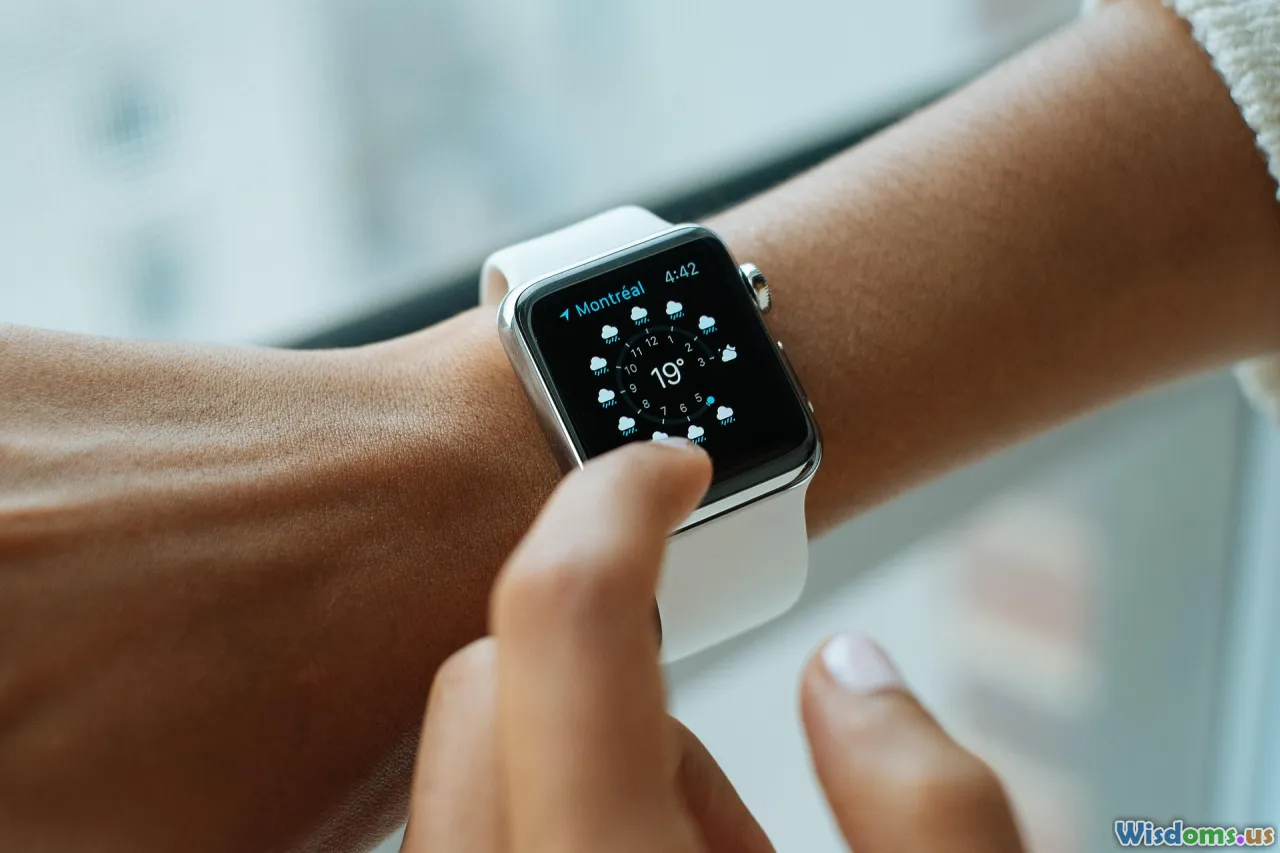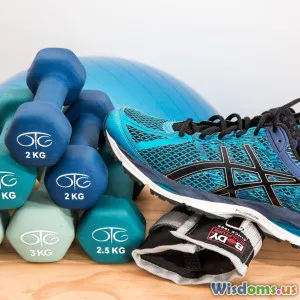
Ten Wearable Fitness Gadgets to Watch This Coming Year
10 min read Discover the top ten groundbreaking wearable fitness gadgets set to redefine health and performance this coming year. (0 Reviews)
Ten Wearable Fitness Gadgets to Watch This Coming Year
In today's fast-paced world, wearable fitness technology continues to revolutionize personal health and fitness. As we surge forward into 2024, new devices are blending innovation, precision, and style to empower users to achieve their wellness goals like never before. Whether you’re a seasoned athlete or just beginning your fitness journey, these ten wearable gadgets herald the next wave of smart fitness tracking—promising to provide unrivaled insights, convenience, and motivation.
1. Apple Watch Series 9: Pushing Boundaries of Health Monitoring
Apple's newest smartwatch iteration, the Apple Watch Series 9, arrives with an enhanced S9 SiP chip and remarkable battery efficiency improvements, extending usage beyond previous generations. Its refined sensors now include advanced haptic feedback and temperature monitoring, features initially emerging in clinical settings but now accessible to consumers.
The new temperature sensor detects subtle changes during sleep, enabling better ovulation tracking and early illness detection, which Apple highlighted during the 2023 keynote. Additionally, the Series 9 refines heart rate and blood oxygen readings, syncing seamlessly with the Fitness+ platform for guided exercises, elevating personalized health regimes.
Apple’s VP of Health Technologies emphasized, “We aim to democratize proactive health monitoring, providing users with clinically relevant data and actionable insights.”
2. WHOOP 4.0: The Science of Recovery & Strain
WHOOP 4.0 refines its dedication to athlete recovery and performance. Unlike screen-heavy smartwatches, WHOOP's minimalist design focuses on 24/7 physiological data without distractions, providing deep analysis of strain, sleep, and recovery.
It introduced the Blood Oxygen monitoring during Wake and Sleep, alongside skin temperature analytics, fueling WHOOP’s AI-driven recovery scores that guide personalized training intensity. Real-world users cite increased productivity and fewer injuries, thanks to WHOOP’s feedback loops.
A study from the University of Utah demonstrated WHOOP’s sleep tracking accuracy surpasses many commercial devices, illustrating its clinical-grade precision.
3. Fitbit Charge 6: Affordable Sophistication
Fitbit continues to make reliable fitness tracking affordable, with the Charge 6 balancing price, features, and style. New stress management metrics—including electrodermal activity (EDA) sensor readings—allow users to understand their physiological responses throughout the day.
The heart rate sensor uses multi-path optical technology to improve accuracy during high-intensity workouts and swimming. Extensive Fitbit community challenges paired with built-in GPS encourage both social motivation and precise location tracking.
Fitbit's Health Equity initiative ensured Charge 6’s skin tone sensor calibrations reduce bias, supporting diverse users in accurate heart health monitoring.
4. Garmin Venu Sq 3: The Versatile Multisport Companion
Garmin, known for durability and robust data, upgraded the Venu Sq 3 with extensive sports mode and anthropometric sensors. The gadget supports everything from trail running and swimming to yoga with pulse oximetry and body battery energy monitoring.
Its new Yoga, Pilates, and HIIT animated workouts on the vibrant color display are particularly appealing for individuals seeking in-device coaching without reliance on a phone.
Furthermore, Garmin’s Connect IQ store provides richly customizable data fields and watch faces, catering to enthusiasts craving personalization.
5. Oura Ring Gen 4: Discreet Wellness Tracker
The Oura Ring Gen 4 exemplifies minimalistic health tracking with remarkable depth. By fitting on a finger rather than a wrist, it collects precise heart rate variability (HRV), respiratory rate, and activity data without interrupting your day.
Its bio-tracking capabilities extend to readiness scores, an integration widely adopted by professional sports teams such as the NHL’s Toronto Maple Leafs for managing athlete fatigue.
Oura’s commitment to user privacy and a battery life of up to seven days solidifies its reputation as a discreet but powerful wellness tool.
6. Samsung Galaxy Watch 6 Classic: Seamless Android Fitness Integration
Samsung’s Galaxy Watch 6 Classic evolves with a refined rotating bezel interface and offers FDA-cleared blood pressure monitoring (where regulations permit). Its enhanced BioActive sensor consolidates three vital sensors, including ECG.
Integration with Samsung Health fosters a unified ecosystem for fitness tracking, sleep management, and stress monitoring. The watch’s AMOLED display and LTE connectivity promote untethered use during workouts.
Sports professionals appreciate its improved real-time coaching and adaptable workout plans, which leverage AI to tailor fitness levels dynamically.
7. Hyperice Venom Go Wearable Heat and Vibration Therapy
Among innovations in wearable recovery devices, Hyperice’s Venom Go stands out with localized heat and vibration to accelerate muscle recovery post-exercise. The sleek wrap design targets hard-to-reach areas like shoulders and calves.
Athletes from NBA to marathon runners incorporate Venom Go within their recovery protocols, praising the combination of soothing heat and stimulation for reducing stiffness.
Clinical data supports the use of heat and vibration for improving blood flow and reducing delayed onset muscle soreness (DOMS), making Venom Go a practical gadget post workout.
8. Whoop Strap Ultra Edition: Enhanced for Extreme Performance
Building on the reliability of its predecessors, the Ultra Edition of the Whoop Strap targets professional athletes and extreme fitness adventurers. It includes titanium hardware strengthening, enhanced pulse oximeter accuracy, and a deeper integration with Whoop’s subscription digital coaching.
It monitors respiratory rate fluctuations indicative of illness early on and offers detailed data on strain balancing with mental health metrics.
Users report advances in injury prevention and optimized training cycles directly linked to insights gleaned from the device’s continuous data streams.
9. Polar Ignite 3: Smart Fitness Meets Elegant Design
Polar has blended style with substance in the Ignite 3, featuring glowing wrist-based HR sensors, Sleep Plus Stages, and a Nightly Recharge recovery metric.
Its FitSpark daily training guide customizes workouts based on recovery and cardio fitness levels, plus new HIIT and running programs.
Its GPS accuracy rivals high-end trackers, supporting triathletes and runners who require multi-discipline metrics.
Additionally, Polar continues open collaboration with NASA, testing sensors to assure durability and precision in extreme conditions.
10. VERT BIO: AI-Powered Posture and Performance Tracker
New on the radar, VERT BIO combines AI with sensor technology to assess posture, breathing, and fitness performance from a compact wearable clipped discreetly on clothing.
It distinguishes itself by incorporating spirometry for lung function, a key metric many wearables overlook, thus seizing a niche in respiratory fitness and rehabilitation.
Clinical trials in physiotherapy clinics show VERT BIO's potential in aiding recovery for patients with chronic respiratory conditions, broadening its appeal beyond athletes.
Conclusion: Embrace Tech To Elevate Your Health Journey
Wearable fitness technology in 2024 is more than just data collection; it’s about delivering actionable insights, tailored coaching, and holistic health management. From versatile smartwatches and discreet rings to innovative recovery devices and AI-powered trackers, the options cater to a spectrum of fitness goals and lifestyles.
By integrating these cutting-edge gadgets into your routine, you not only track metrics but deeply understand your body, enabling smarter decisions and sustained motivation. As innovation accelerates, staying ahead with these ten devices ensures you leverage technology’s full potential for a healthier, more active life.
In the words of fitness tech expert Jennifer Carmichael, “Wearables have evolved from fitness counters to personal health partners, making the journey toward wellbeing an informed, personalized, and even enjoyable adventure.”
Prepare to step into 2024 armed with the knowledge of which wearables can truly transform your fitness experience.
Rate the Post
User Reviews
Popular Posts















